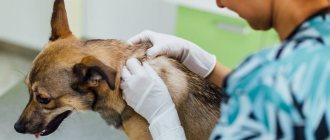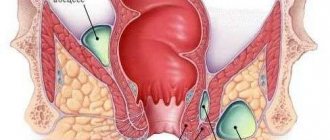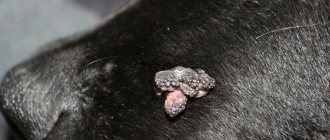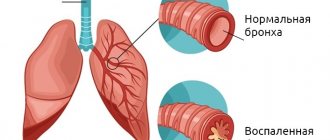What causes crusts to appear on a dog's ears?
Animals' ears are a tool that allows them to navigate the surrounding space and correctly perceive sound signals. Due to ear problems, your dog may soon lose his hearing, which will be detrimental to his health and quality of life. A healthy pet's ears should be clean, uniform in color, free of crusts and sores, and a slight build-up of wax is allowed. When a dog has crusts on its ears, this indicates the presence of a disease. You should not try to soak them with water or tear them off; it is necessary to urgently determine the cause of the problem and begin timely treatment to avoid irreversible consequences.
Why does my skin peel?
The skin is an integral organ of the immune system, which consists of many elements: epithelium, endothelium, hair, sebaceous glands . Their joint work regulates the body’s defense functions, and disruption of at least one component results in a general loss of immunity and frequent illnesses.
Causes of lesions inside the ear
- Seborrhea (dandruff) caused by nutritional imbalance, pests (check your ears, there may be mites there).
- Thermal or mechanical injuries. If your dog has damaged the area of skin behind the ear, it will peel as it heals.
- Disruption of the sebaceous glands. When they produce too little sebum, the skin becomes dry and flaky.
- Allergic reactions to medications or food.
But why the skin suffers only on the ears is a separate question. If the rest of the body is healthy and unharmed, then the ears are a place weakened by certain factors . This can be either inflammation or pathogens.
Red or dirty
Inspect your ears for dirt; it is quite possible that the dirt that came from the street contained toxins or toxic substances . If there is plaque on the ears, redness, unpleasant odor, swelling, this indicates the presence of a disease that needs to be diagnosed.
We recommend reading: How is Feline Ringworm Transmitted to Humans?
Ear mite
When infected with ear mites, lesions form not only in the ear canals, but also on the tips of the ears. This parasite, penetrating inside the shell, is absorbed into the upper layer of the skin and feeds on its keratinized areas. Its intense vital activity causes severe itching and inflammation in the animal. At the beginning of the inflammatory process, crusts appear inside the auricle. Without treatment, the disease will begin to progress, suppuration will appear, and parasites will actively multiply, which will greatly affect the health and condition of the dog.
Additional symptoms of mite infestation include an unpleasant odor from the ears and the accumulation of a dark brown mass in the ear shells. Treatment for ear mites includes several stages:
- Cleaning the ear canals with a cotton swab soaked in hydrogen peroxide.
- Instillation of special drops.
- Treating the crusts with brilliant green.
If treatment is not started on time, the developing inflammation will spread to the brain and can lead to the rapid death of your beloved pet. To avoid infection with ear mites, it is necessary to maintain hygiene and regularly clean your ears, maintain immunity, and monitor the quality of food. Proper care and nutrition are fundamental factors.
If your dog has crusts on the tips of his ears, this could be the cause of dermatitis. At the same time, the disease affects not only the ears, and is usually accompanied by the appearance of small ulcers and peeling on other parts of the body. If the disease process is not advanced, then special ointments will help cope with dermatitis.
What causes crusts, wounds and bleeding
There are four main reasons why sores may appear on the surface of a dog’s ear.
Mechanical damage
Quite often, dogs develop crusts on the tips of their ears due to injury. You can accidentally damage your ear while hunting, in a fight with other animals, and even during a normal walk. If the wound is not very deep and has not started to bleed heavily, it is simply treated with an antiseptic. More serious injuries may require stitches.
Mechanical injuries also include:
- Frostbite. If a dog's ear gets wet while walking in winter, he may get frostbite. This can cause blisters to appear on the surface of the skin. The frostbitten area of the ear begins to turn red and swelling forms.
- Burns. Overly active pets are most likely to suffer from burns. Due to carelessness or inattention, they may knock over a container with boiling liquid or touch a hot surface. This can cause the affected area to become blistered or crusty.
Additional Information. Quite often, long-eared breeds encounter mechanical ear injuries: terriers, spaniels, beagles, bloodhounds.
Fungal infection
Poor appetite is one of the signs of a fungal infection.
If your dog's ears are peeling, there is a chance that he is suffering from a fungal disease. Such diseases occur in most villages. It is not easy to cure them, but with proper treatment, complete recovery can be achieved.
There are several reasons for the activation of non-pathogenic fungal microflora. Most often, the infection develops due to poor diet, frequent hypothermia and decreased pet immunity. All this leads to the spread of dangerous microflora, which subsequently causes the development of pathology.
The following symptoms indicate the development of a fungal infection:
- Severe itching. The affected areas of the skin begin to itch constantly. Because of this, the dog scratches the skin and sores appear on it.
- Foul smell. An unpleasant odor coming from the ears is one of the main signs of infection.
- Decreased appetite. Sick dogs begin to eat worse and become less active.
- Anxiety. If a pet develops a fungal infection, it may begin to exhibit behavioral changes and become restless.
Dermatitis
Dermatitis is a disease that can cause sores to appear on the ears.
Dermatitis is a serious inflammatory process that can lead to sores on the dog’s ears. This disease appears after a pet swallows or inhales an allergenic substance to which it is highly sensitive. When an allergen enters the body, a rash and other signs of an allergy appear on the outside of the ears or other parts of the body.
Additional Information. Dermatitis can appear unexpectedly in a dog. Sometimes it occurs as a response of the body to substances that have never previously caused allergic reactions. This happens because sensitivity to certain substances can increase gradually.
There are a number of symptoms that appear in animals with ear dermatitis. These include the following:
- Itching. When a dog develops crusts on the tips of its ears, it begins to actively scratch them.
- Scratching. As a result of severe itching and constant scratching, scratches appear on the ears of pets.
- Swelling. If dermatitis is left untreated, swelling may be noticeable on the outside of the ears.
- Bleeding. Minor bruising appears in the areas where the crusts are located.
- Hair loss. Hair may begin to fall out on the affected areas.
Also, characteristic signs of the development of dermatitis in a pet include the fact that it constantly bites or licks its ears.
Ear mite
Ear mites can appear in dogs of any breed.
Yorkies can develop sores on their ears due to ear mites. It is because of this that scabies appears and begins to develop in dogs. There are two types of mites that can cause ear problems:
- Sarcoptes scabiei. This is a rather dangerous parasite that causes sarcoptic mange in pets. This is a common skin disease that causes sores to appear on your dog's ears.
- Demodex Canis. After being bitten by this tick, dogs may develop demodicosis. This is a serious disease that at first seems completely harmless. However, if treatment for demodicosis is not started in time, the disease will begin to affect internal organs.
Additional Information. The listed types of ticks are considered contagious, and therefore sick animals must be isolated from other pets living with them in the same apartment.
The main symptom of ear mites is severe itching, which is accompanied by hair loss. Not only the dog’s ears begin to itch, but also other parts of the body. Pain in the joint area may occur. Another distinctive symptom is the appearance of a darkish coating on the inside of the ears. This black coating is ichor, which flows from the areas of the skin affected by mites.
Fungal infection
Fungal infections of the ears are common, take a long time to treat and are quite problematic, and it is not always possible to predict a complete recovery. Poor nutrition, decreased immunity, and hypothermia can provoke non-pathogenic fungal microflora (it is present in a healthy animal’s body) to actively reproduce and cause serious pathology. Fungal waste appears in the form of dark crusts in the ear canals, as well as ulcers on the animal’s fur. The main symptoms of yeast infection of the ears are:
- unbearable itching;
- there is a foul smell from the ears;
- decreased activity and appetite;
- restless behavior.
Against the backdrop of a pronounced development of an infectious disease, the animal tears its ears until they bleed, thus activating the process of inflammation. Scabs with pus and crusts with dried blood form in the pet's ear canals. A constant companion of fungal infection appears - a foul odor from the ears. Treatment is carried out in several stages and consists of the following points:
- treatment of the ear canals with special solutions;
- the use of substances that dilute the sulfur mass;
- use of antimicrobial and antifungal agents;
- following a specially designed diet.
Photos of dogs with crusts on their ears
In case of an unadvanced form of the disease, treatment is carried out at home with strict adherence to all recommendations. For acute abscesses in the ear canal, in a clinical setting, an autopsy is performed and blood clots and pus are removed. At a further stage, the affected areas are treated with antiseptic drugs.
If dry crusts appear on your dog's ears, or if he exhibits strange and restless behavior, you should immediately seek help from a veterinarian, as this may be a sign of a serious illness. It is necessary to be especially attentive to your pets and to quickly restore health, start treatment on time.
My dog has small crusts on the tips of his ears. I began to notice that she began to itch on corners and other hard surfaces. We went to the vet and it turned out that we had a fungus. They prescribed 2 ointments + regular rinsing with chlorhexidine.
My English Bulldog constantly has crusts inside his ears. I treat it with chlorhexidine and apply regular baby cream. 2 different veterinarians said that this is a feature of the breed - allergies.
I have a cocker, a 3-year-old girl, after her heat, dry crusts appeared on the tips of both ears. I tried to scrape them off, the dog behaved calmly, which means they didn’t hurt. I also treated it with chlorhexidine, I’ll wait a few days, if it doesn’t go away on its own, I’ll take the dog to the vet.
And we are a French boy, 3 years old. Also, with the beginning of summer, I noticed that dry crusts appeared on his ears and inside. I tried to pick it up, it fell off like dandruff. I've applied baby cream for now, but if it doesn't go away in a couple of days, I'll take it to the vet.
Allergic reactions
Ear diseases caused by allergies often manifest themselves throughout the body: the dog tries to bite itself, severe itching spreads throughout the body, and purulent fluid begins to be released from the ears in abundance. In rare cases, swelling may occur. There is also a crispy crust on the tips of the ears.
Allergies in a dog's ears
Severe cases of allergies manifest themselves in characteristic salivation and loss of coordination.
In this case, it is necessary to identify what caused the manifestation of such reactions and remember what the dog was fed. It is necessary to exclude these products from the menu and put your pet on a strict diet. In some cases, the veterinarian may prescribe antiallergens: Erius, Exekan, Suprastin. In emergency cases, injections of antihistamines are used, the dose of which is calculated based on the pet’s weight.
Ear sores in dogs: Causes
There are several factors that contribute to the appearance of wounds on the auricle.
- Insect bites . Very often, especially in dogs living in the southern regions, in the warm season, lesions on the tips of the ears are noticeable, and there may also be sores on the back of the nose. Flies are the culprit, but other blood-sucking insects can also harm our pets in similar ways.
- Dermatosis of the edges of the ears. The breed most prone to this problem is the dachshund. This pathology looks like crusts on the fur and skin along the edge of the ears. The reason for this phenomenon is not fully known. As a rule, it does not cause concern to the dog.
- Vasculitis. This is inflammation of the walls of blood vessels. With this pathology, tissue nutrition is disrupted and they can become necrotic. It may look like a blackened area of the ear, or an uneven edge of the auricle. This disease is autoimmune in nature.
- Other autoimmune diseases. The lesions are often symmetrical.
- Injury. With mechanical damage, a sore can form on the ear, for example, a dog was playing with a cat, and the cat hit it with a claw. An additional symptom may be a hematoma of the auricle. When traumatized, a blood or lymphatic vessel bursts and the ear swells locally, forming a soft “pad”.
- Parasitic diseases. For example, demodicosis. In addition to damage to the skin, there may be no fur.
- Fungal diseases. For example, ringworm. The fur may also be injured, the skin may become red with peeling and crusts.
- Bacterial infections. Both secondary and primary. They can cause ear sores.
There are other types of dermatoses and dermatitis; diagnostics are required to clarify the causes.
Watch the video: Skin diseases in dogs - causes, methods of elimination
How can you tell if your dog has ear pain?
There are the following symptoms of ear problems in dogs, which can help you determine your pet's condition.
- The dog begins to scratch his ears until they bleed.
- The dog's ear tissues are damaged and swelling occurs. It covers not only the passages, but also the tips of the ears.
- The ears begin to smell not very pleasant.
- In rare cases, pus is released.
- During a walk, the dog may tilt its head to one side.
- The ears become a source of pain. Any touch is accompanied by a plaintive howl.
Sore on a dog's ear. The ears are damaged. Diagnostic methods
As you have already learned, there are a lot of reasons, and they are all very different from each other, including in treatment.
Veterinarians recommend diagnostics for correct diagnosis and effective therapy:
- Skin scraping. Deep and superficial. To exclude parasites.
- LUM diagnostics to exclude certain types of dermatophytes.
- Cytological examination of the skin.
- Histological examination. Required, for example, to confirm vasculitis.
Sore on the tip of a dog’s ear: How to help at home
If your dog has crusty sores on the tips of his ears, and you won’t get to the doctor soon, then you need to carry out initial treatment.
Soak the scab (crust) with chlorhexedine or saline and carefully remove. The tips of the ears can be lubricated with a healing ointment, for example, Ranosan or Levomekol.
Put a protective collar on your dog to avoid self-injury.
If you haven’t been treated for ectoparasites for a long time, now is the time to do it. The drug Advocate has a repellent (scaring) effect.
Watch the video: Flea dermatitis in dogs and how to recognize it
The tips of a dog's ears are sore: Treatment
You can only treat your dog symptomatically on your own. If you do not eliminate the cause, the sores may appear again and again.
For parasitic diseases, appropriate treatment is required, depending on the type of pathogen. For demodicosis, the drug Bravecto is suitable, repellent against flying insects is Advocate.
Dermatosis of the edges of the auricles, unfortunately, cannot be completely cured; the disease can recur. For prevention and treatment, exfoliating shampoos are used, for example, Keratolux. You can also use Doctor green shampoo with benzoyl peroxide as a preventive measure.
For vasculitis and other autoimmune diseases, immunosuppressive therapy is used, for example, the drug Atopica.
For secondary infection, local or systemic antibiotic therapy is prescribed, for example Bactroban ointment or Cephalen tablets.
To maintain the skin and restore damaged cells, veterinarians recommend the use of vitamins, for example, Excel Brevers , Laveta Super or Super Coat.
Essential drops on the withers with omega-3 and omega-6 fatty acids have proven themselves well. They can be applied both to the skin in the withers area and topically to the damaged area.
For severe itching, Stop Itching spray or Cortavance can be used topically.
Don't forget the Elizabethan collar to protect against additional injury.
Clinics where you can go with a dermatological problem
Saint Petersburg:
- Veterinary Clinic named after. Ivan Fillmore. They work around the clock. The clinic is equipped with all the necessary equipment for successful and quick diagnosis. An appointment with a dermatologist costs 1,500 rubles. 50% discount on services for homeless animals.
- AlterVet. The clinic is open 24 hours a day. There is a gym for pets. Reception is conducted by specialists with extensive experience. Lots of positive reviews and satisfied customers. The clinic often holds promotions and discounts.
- Vetus veterinary clinic network. Doctor's appointment from 550 rubles. Clinics operate around the clock. Highly qualified specialists work here. I would especially like to note the professionalism of dermatologist Elena Valerievna Genrikh.
Moscow:
- Movet Clinic. Works around the clock. Admission 900 rubles. The clinic provides many veterinary services. There is a doctor's house call.
- Jenk. Doctor's appointment from 300 rubles. The clinic provides the service of transporting the patient from home to a medical facility, which is undoubtedly very convenient. The clinic has a pet hotel and an animal shelter. A narrow specialist dermatologist works. A groomer also offers his services.
- Hachiko. Free consultation for pet owners. Wide range of services at affordable prices.
Do you like the article you are reading now? Look at other materials on this site: What can you give your dog for worms: Doctor's recommendations - https://strazhchistoty.ru/cleanup/cleandogs/chto-dat-sobake-ot-glistov.html Vomiting in a dog without diarrhea and fever: What should the owner do ? — https://strazhchistoty.ru/cleanup/cleandogs/rvota-u-sobaki-bez-ponosa-i-temperatury.html
Rostov-on-Don:
- Clinic Vita. Appointment with a dermatologist 500 rubles. The clinic has its own veterinary laboratory, which speeds up the process of obtaining test results. 24/7 operation.
- Veterinary clinic of Dr. Petrenko. Appointment with a dermatologist 500 rubles. Animals are accepted until 22.00. There is a day hospital.
- Amigo. 24/7 operation. The clinic cooperates with large veterinary laboratories. A wide range of veterinary services: grooming, pet hotel, therapy, surgery, dermatology and much more. Experts welcome evidence-based medicine.
The dog has crusty sores on the tips of his ears. Analysis of reasons and recommendations
When dogs develop sores on their ears, owners who imagine themselves to be experts use potent drugs and cause irreparable harm to their pets. If you use a universal antibiotic, pathogenic fungi are activated. Uncontrolled use of antimycotics increases the proliferation of pathogenic cocci. In addition, medications can provoke allergic reactions.
I have compiled an overview of the causes of ear sores. I have selected medications that you can use yourself. Determined in what cases to seek veterinary help.
If you have established a preliminary diagnosis, go to the “Treatment” section. The sequence of your actions is described step by step there.
Analysis of the reasons for the appearance of crusts on the ears
The disease mainly affects short-haired pets that lead an active life and are exposed to environmental influences.
The most common reasons:
Long-eared pets are most often injured Hunting dogs get into fights with animals, scratch themselves on thorny plants and burrow arches. If dogs live in apartments, they still manage to get injured while walking. Minor abrasions and scratches heal unnoticed by the owner. If a dog accidentally picks off a scab, ichor is released and crusts begin to appear. Treat the defect with any antiseptic spray, which a responsible dog breeder should always have in his first aid kit. If the dog itches, picks off scabs, or bleeds at the tip of the ear, don’t take risks, visit the veterinarian.
Vasculitis is an inflammation of the capillary walls. Experts consider the disease to be an autoimmune disease. Initially, small blood vessels are affected, of which there are many at the tips of the ears. Skin tissues do not receive nutrition and die. The new epidermis does not have time to form, and a wound surface forms. The secreted ichor dries out and crusts form. Pathology has a predisposition to relapse. Characterized by the following symptoms:
- formation of ulcers;
- swelling;
- hair loss;
- touching the ear is painful.
The disease is distinguished by its duration and lack of improvement. If you notice that regular antiseptic sprays or powders do not work, contact a specialist.
Dermatosis of the edges of dog shells occurs mainly in dachshunds and other dogs with drooping ears. Develops in puppies and old dogs, apparently due to weakened immunity. In most cases, the cause cannot be determined, which is why the dermatosis is called idiopathic. The edges of the shell, covered with scabs, hypertrophy, and with the transition to chronic inflammation, alopecia develops. The skin cracks and peels off. Sores form, the dog shakes its head. The width of the cracks increases, exudate is released, hardens, crusts form, and the tips of the ears peel off. There are no other symptoms for dermatosis.
Dermatosis of the edge of the ears
Sarcoptic mange is scabies caused by a microscopic mite. Dog breeders confuse the disease with otodectosis, however, the ear mite affects the inner surface of the shell, and Sarcoptes is located on the outside. The arthropod parasitizes the part of the skin rich in nerve endings, so itching is felt immediately after the dog is infected. At the first stage, patches of baldness appear on the face and ears. If treatment is not started in time, the disease will quickly spread to the entire surface of the body. Areas of hairless skin, ulcers, fistulas, and ulcers form. Therefore, if you notice the signs mentioned above, contact your veterinarian. Ticks can attack humans and cause short-term itching in children and the elderly.
Sarcoptes
Ectoparasites - fleas that pester the dog in the summer; lice and lice-eaters become more active in the winter, when their competitors - fleas - lose activity. The result of arthropod activity is dermatitis. The tips of the ears, fur and skin are affected. Lice and fleas feed on ichor. Lice eaters secrete a sticky secretion, form tangles, inside which they create ideal living conditions.
Ear diseases of dogs
The list of diseases is extensive, but we will list the most common ones:
- Allergic reaction. As in humans, it can be triggered by various reasons: food, medicine, household chemicals, skin and fur care products, dust, insect bites and much more. The dog actively scratches its ears, their tissues swell and redden, become inflamed, and become covered with a large rash. The dog suffers greatly from itching. The condition usually requires the intervention of a veterinarian.
- Hormonal disorders. The most affected breeds are those with long, floppy ears, such as dachshunds, cocker spaniels, setters, beagles, basset hounds and bloodhounds. It is difficult to treat disorders; it requires a lot of time and the use of precisely selected hormonal drugs. More often than others, these dogs develop hearing problems due to pathological changes in the thyroid gland.
- Inflammation of the outer ear. The cause of the disease is often hypothermia or water getting into the ears. Accompanied by copious, unpleasant-smelling discharge, pus, and sometimes an unusually large amount of earwax is produced. When the condition is neglected, under the influence of constantly weeping tissue, eczema can develop. Long-eared dogs are more susceptible to the disease.
- Inflammation of the middle ear. It can be a complication after a general illness that greatly weakens the animal’s immunity. Through the flow of blood and lymph, the infection penetrates into the middle ear, causing first swelling, then suppuration, and severe pain. If treatment is not started immediately, neighboring organs are involved, the eyes are affected, the dog cannot eat and drink normally, it is in pain, sleep and behavior are disturbed. The dog shakes its head, tilting it towards the diseased organ, often itches, which can damage the skin, spreading infection. The disease is dangerous due to complications and can cause meningitis and disruption of the normal functioning of the vestibular apparatus, which regulates the sense of balance. The disease is treated with antibiotics, gentle cleaning of the ears, treatment with anti-inflammatory drugs, and the prescription of special ointments. In severe cases, surgery may be used.
- Otodectosis. The cause of the disease is a microscopic mite, which settles in an ideal place for it with constant humidity and heat. It penetrates under the skin, into the hair follicles, where the tissues are the most delicate and thin. The ears are the tick's favorite place; there is the thinnest skin and many capillaries. The parasite lives its entire life in the pet's skin, causing him severe suffering. The presence of a pest is indicated by constant itching, the formation of crusts and exudate flowing from under them. For treatment, specialized drugs are used, selected individually by the veterinarian.
- Eczema. This disease can be inherited, be autoimmune, or be caused by problems with the nervous system. Often the appearance of eczema is caused by severe stress, for example, a change of owners or moving to another home, the appearance of a new family member - a child or a cat, a dog. It is difficult to treat the disease; non-steroidal anti-inflammatory drugs and ointments are used, as well as other means at the veterinarian’s discretion.
- Hematoma. It can appear after a bruise, a blow, or after any rough physical impact. Blood accumulates at the site of impact and interferes with the normal functioning of the hearing organ. The bruised area hurts and bothers the animal, which can lead to damage from the claws. Often a hematoma is removed surgically; the sooner the better. After the operation, the animal is prescribed a course of antibiotics, antihistamines, anti-inflammatory and painkillers.
- Mechanical damage. Their appearance can be provoked by owners who are too energetic in cleaning their pet’s ears, or by the dogs themselves, who accidentally damage sensitive tissues when brushing. Such wounds, with proper care, heal quickly, but if you do not pay attention to them, they easily become entry points for infection - bacteria or fungi.
Treatment recommendations depending on the cause
Treatment consists of eliminating the causes of the disease:
Treat injuries, abrasions and scratches by applying an antiseptic to the affected area. I recommend aerosols, they are easy to use. Terramycin spray with a volume of 150 ml costs 490 rubles.
Terramycin
A budget option is brilliant green (10 r/10 ml) or hydrogen peroxide (10 r/100 ml).
For vasculitis, the veterinarian prescribes a comprehensive treatment that combines drug and symptomatic therapy. A monthly course of antimicrobial drugs can prevent the development of pyoderma. The next stage is the use of immunosuppressants. Corticosteroid antiphlogistants are used. In most cases, treatment becomes lifelong. The disease threatens the life of the animal, so follow the instructions of the specialist.
Dermatosis is treated with symptomatic means. Cleansing shampoos are effective when applied several times a day until complete recovery.
To treat sarcoptic mange, use external acaricidal preparations. I recommend Amit-Forte in solution form. Treat the affected crusted surface with a cleansing shampoo. Apply the solution in a thin layer, covering a 10 mm wide strip of clinically healthy tissue. The drug does not kill tick eggs. Therefore, after 5 days, repeat the treatment. If after 5 days the pathological lesions remain, apply the acaricidal agent again until complete recovery.
Amit-Forte
If lice are found on the tips of the ears, it means they are spread throughout the dog’s body. Therefore, treat your dog with Bars insectoacaricidal spray, RUR 230. per bottle 100 ml. The drug destroys lice and protects the dog from repeated attacks for 14 days. Therefore, several treatments are required until the parasites are completely destroyed and the pathological symptoms disappear. In the intervals between treatments, remove tangles - lice hide in them from the action of the insecticide. Budget option - Butox. If the dog lives in an apartment, treat the room with the same products.
Treat fungal diseases with external means before the pathological focus spreads. I recommend Zoomicol spray. A 100 ml bottle costs 440 rubles. Spray the aerosol from the center to the periphery, capturing 1.5-2 cm of unaffected tissue. Repeat the treatment twice a week until recovery. A budget option is Yam ointment. A jar weighing 50 g costs 100 rubles.
If your dog is bothered by flies, you need to use repellents that have a wound-healing effect. I recommend birch tar. Buy a 100 ml bottle at the pharmacy for 100 rubles. Lubricate your ears as needed until they heal. Tar repels insects, destroys their larvae, pathogenic bacteria, and fungi. However, this is not enough. Avoid natural foods. It is unbalanced and attracts insects. If you don't mind the money, switch your pet, at least to Chappy, which contains a minimum of nutritional components to maintain the protective barriers of the skin.
When dermatitis of allergic etiology develops, try to identify irritants and interrupt the dog’s contact with them. If your dog is allergic to food, consult your veterinarian and choose a hypoallergenic diet.
If you have any questions, write comments, I will try to answer everyone.
Bibliography.
- Diseases of dogs and cats [Electronic resource]: comprehensive diagnosis and therapy: a textbook for students of agricultural universities studying in the specialty 110800 “Veterinary Medicine” [Starchenkov S.V. et al.]; edited by A. A. Stekolnikova, S. V. Starchenkova. St. Petersburg: SpetsLit, 2013 - 924 p.
- Paterson Sue. Skin diseases of dogs, Aquarium Print, 2011 - 176 p.
Sores on the tips of a dog's ears
A dog's ears are one of the most important organs that provide it with a comfortable existence, but it is a fragile organ. It is on the ears that the first signs of various diseases often appear.
In a healthy state, the tips of the ears of dogs of any breed should have smooth, undamaged skin. Any wound, scratch, ulcer, growth or scab may already indicate the development of the disease and the need for serious treatment.
Vasculitis is an inflammation of blood vessels caused by a disorder of the animal's immune system. The body begins to attack itself, because of this, small vessels are destroyed and bruises and wounds appear on the skin, quickly healing with brown crusts.
The first organ to show signs of the disease is almost always the ears, since the small blood vessels in them run very close to the surface. This problem can affect any dog, regardless of age or gender. Veterinarians have not identified any statistics indicating that young animals get sick more often than older ones.
Symptoms of vasculitis:
- Small wounds on the tips of the ear, covered with crusts.
- Redness of the affected areas.
- Hair loss in areas of redness and vascular damage.
- Gradual swelling of the development focus.
- The appetite decreases sharply, causing the dog to rapidly lose weight.
- Severe pain.
- Periodic febrile seizures that go away on their own after a short time.
Vasculitis itself never occurs; in essence, it is rather the body’s reaction to a more serious problem.
The development of vascular inflammation can be provoked by:
- Some types of infections.
- Development of autoimmune diseases.
- Reaction to the administration of certain medications. Quite often it occurs either after vaccination with a new vaccine that has not yet been tested by this dog, or after using self-prescribed medications.
A huge problem for owners is an accurate diagnosis, since when contacting a veterinarian with such symptoms, the possibility of infection by parasites is first checked, and only after that research begins to help establish the true cause of what is happening:
- Analysis of urine.
- Complete blood test.
- Biochemistry of blood.
- X-ray or ultrasound examination of internal organs is carried out immediately after confirmation of suspicion of vasculitis, as this is the only way to determine the degree of neglect of the process and the damage caused to it.
Vasculitis is only a symptom of another, more dangerous disease, so you can get rid of it only after identifying the root cause and curing it.
At the same time, it is almost impossible to cure a dog at home on your own, since complex therapy using a number of drugs is required.
Ear mite damage is one of the most common causes of problems in domestic purebred dogs, since they have a much weaker immune system that does not protect against parasites. Even an animal that is not outdoors but comes into contact with other animals can become infected.
Almost all stray dogs are affected by this parasite.
Microscopic insects, falling on the inner surface of the auricle, bite under the skin and gnaw passages in it, feeding on particles of the epidermis and bloody secretions. Because of this, crusts and sores begin to form on the tips of the ears, and brown scabs appear, which are waste products of mites.
If the onset of infection is not noticed in time, then over time it will lead to the development of otitis media, and in particularly advanced cases it can provoke replenishment of the brain. Therefore, when you see the first mild signs of infection, you need to start taking action.
Vasculitis
In the case of this disease, in addition to the formation of crusts at the end of the ear, the dog also experiences hair loss in the affected area. Also, in most cases, intense redness appears over most of the inner side of the ear.
Vasculitis is an inflammation of the walls of blood vessels that develops due to an improper immune response of the body to its own tissues. The ears are the first to be affected. The disease cannot be called common, but it can occur in animals of any age. Crusts on the tips of a dog's ears when the disease occurs are formed due to the fact that the walls of the blood vessels are damaged and numerous small wounds appear, which are quickly covered with a crust, usually brown in color.
Treatment of vasculitis is complex. For some animals it is a course, after which the problem is completely eliminated; and for others, lifelong therapy is required. You should also take into account the fact that the disease can recur after the outbreak is eliminated. Because of this, the condition of a dog that has encountered vasculitis requires constant monitoring.
Treatment at home
In some cases, it is not possible to contact a veterinary clinic immediately after detecting symptoms. But this is not a reason to leave a dog with wounds on the tips of its ears without help. There are several ways that can improve your pet’s situation before receiving qualified help:
- A regular pharmacy sells birch tar . You can lubricate the wounded area with it several times a day, this will protect the animal from infection and contribute to a speedy recovery.
- Tar can be replaced with Vishnevsky ointment , which has the same effect.
- Also, in order to protect the animal from infection and the spread of infection, it is necessary to wash the lesions with a solution of furatsilin , and then treat them with streptocide on top.
- If you know for sure that the wounds are the result of mechanical damage (a fight or an unsuccessful fall), then treat the damaged surface with hydrogen peroxide and anoint it with brilliant green.
- If you suspect an allergy, you need to review your diet. Until the exact cause is determined, exclude all cereals and most vegetables from your daily menu. Potatoes are considered especially dangerous.
All of the above measures will only help to avoid the spread of infection and deterioration of the animal’s condition. Even if they give a positive result, it will still be necessary to contact a veterinarian to determine the exact cause of the condition and prescribe the necessary treatment.
Preventive measures for ear diseases
Despite the severity of ear diseases, they are quite easy to cure. To do this, you need to contact a veterinarian in time to prescribe timely treatment. But you can prevent the disease by caring for your dog's ears.
Your dog's ears need to be cleaned periodically
To do this you need:
- clean your pet’s ears using a damp cotton wool or swab, but do not be zealous;
- remove excess hair from the ear: for this you can use an arterial clamp, but a depilatory cream is better;
- After swimming, it is good to wipe away any water that gets into your ears;
- If the dog does not whine, but strange redness has formed inside, you should immediately contact a veterinarian.
Video - How to clean your dog's ears?
Causes
The etiology of the disease may be different. We will look at the most common cases.
Otodectosis
Or, to put it simply, an ear mite. This is probably familiar to many, because it is a fairly common phenomenon. When a tick settles in your pet's ear, it goes to the top layer of skin and feeds on its particles.
Its waste products lead to itching. As a result, the dog begins to intensively scratch its ears. Hence the appearance of sores in the dog’s ears.
How can you tell if your dog has otodectosis?
- there are dark lumps inside;
- redness;
- unpleasant odor;
- itching
How to cure it yourself?
Getting rid of ear mites is not at all difficult, the main thing is to follow the regularity of procedures.
Ear cleaning
The main thing is not to use cotton swabs, because you can damage the eardrum.
Take a solution of Chlorhexidine (special ear lotions are available in pet stores), drop a very small amount into the ear and cover the auricle with your palm for a few seconds. Next, let the pet shake its head. We wipe all residues from the ear with a cotton swab.
Carry out the procedure every day 2 times.
For dogs with skin problems
Treatment with drops
You can purchase the appropriate drops in pet stores and veterinary clinics. They should be used according to instructions.
For example, Dekta Forte into the ears every 3 days.
At the clinic, the doctor will be able to examine a sample from the ear under a microscope and accurately confirm the diagnosis.
Lichen
Another very unpleasant disease that can also be contracted by humans.
Ringworm is caused by a fungus that causes redness and itching. Distinctive features: hair loss and rough skin, which can appear not only on the ears. If you suspect, it is better to immediately contact a specialist.
Treatment at home
Fluconazole 1/10 capsules taken once a day for 10 days. You can dilute it with water and give it to your pet through a syringe without a needle, or mix it with food.
You should also buy an antifungal shampoo and use it once a week for 10 days.
Biopirox spray . There is also a vaccine called Vakderm .
The veterinarian will be able to examine your pet and perform fluorescent diagnostics to make a diagnosis.
For the treatment of lichen
Allergy
Owners love to feed their dog food from the table, and this can have negative consequences.
Food allergies are manifested by the appearance of sores in the animal, redness, local hyperemia and itching (on the ears and/or paws). In addition, general swelling and lacrimation appear.
How is the treatment carried out?
If you are sure that the cause is an allergy, you need to eliminate its source and give your pet antihistamines, for example Suprastin , Loratadine .
Clinics perform allergy tests to identify the exact allergen. Blood is donated for tests, where the number of eosinophils can be used to check whether the dog really has an allergy.
Allergy medications
Vasculitis
Even the most inattentive owner can find crusty sores, ulcers and scabs on the tips of his dog’s ears.
This disease is characterized by inflammation of blood vessels, resulting from a malfunction of the body's immune response to its tissues. Due to damage to the walls of blood vessels, small wounds appear. Most pronounced on the ears.
Treatment at home is not recommended, because it is individual for each case. Some patients complete the course, others are treated for life.
If possible, you should consult a specialist. After all, it is not always possible to make a diagnosis via the Internet. It may turn out to be inaccurate, which means that the treatment will be ineffective.
Posts 1 page 21 of 21
Share12020-07-26 03:54:30
- Author: Domovenok
- Active participant
- From: Moscow
- Registered: 2020-04-16
- Posts: 1654
- Respect: +112
- Positive: +500
- Female gender
- Age: 60 [1959-03-08]
- Time spent on the forum: 9 days 18 hours
- Last visit: 2020-07-11 01:37:23
Ear diseases in dogs
A dog's ear consists of three parts: outer, middle and inner. The outer ear is the pinna, the shape of which depends on the breed of the dog and is highly variable. The auricle and middle ear are connected by the auditory canal, which is closed at the end by the eardrum. The middle ear is located in the bony cavity of the skull. Its cavity is limited by the eardrums, between which there are interconnected bones that transmit sounds from the middle ear to the inner ear. The inner ear is the main part of the hearing organ and the organ of balance. Here are the nerve endings that convert the sound signal and transmit it to the centers of the brain.
There are diseases (otitis) of the external, middle and inner ear. Chronic otitis media is difficult to treat and, as a rule, spreads over time to all parts of the hearing organ. These diseases are dangerous because the inner ear is directly connected to the brain, which can also be involved in the pathological process, and there is a possibility of hearing loss. An increased amount of sulfur and an unpleasant odor from the ear are noted. With long-term disease, the skin of the ear canal and pinna becomes rough and thickened and can block the ear canal.
Inflammation of the outer ear is best treated in the acute stage of the process. First of all, carefully and carefully clean the external auditory canal. To clean the ear, it is better to use vegetable oil or petroleum jelly rather than irritating liquids. In case of heavy discharge, the ear canal is powdered with special powders or powders (the powders usually contain antibiotics, for example, tricillin, xeroform or iodoform, anesthesin, boric acid). If there is almost no discharge, you can apply ointments (synthomycin liniment mixed with nystatin ointment). In order to select the appropriate antibiotic, you can do a bacteriological analysis of the microflora of the ear. Therefore, the owner needs to monitor the condition of his dog’s ears, especially if the dog’s ears are drooping: such ears are more susceptible to infectious diseases.
We recommend reading: Megestrol acetate for dogs ex-5 for false pregnancy in a dog
Share22020-07-26 03:55:35
- Author: Domovenok
- Active participant
- From: Moscow
- Registered: 2020-04-16
- Posts: 1654
- Respect: +112
- Positive: +500
- Female gender
- Age: 60 [1959-03-08]
- Time spent on the forum: 9 days 18 hours
- Last visit: 2020-07-11 01:37:23
Ear diseases are often accompanied by the following symptoms:
- Abnormal ear discharge or excess wax buildup - Dogs have a buildup of wax in their ears, a thick yellow or brown colored substance. Normal sulfur has a weak specific odor. A plaque of wax forms in the auricle or on the walls of the ear canal. Excessive wax is a clump or thick crust that covers the outer ear. If the wax changes color or consistency, it is considered abnormal discharge
- unpleasant odor from the ear - usually occurs with inflammation. Often an unpleasant odor is associated with pathological discharge, but sometimes no discharge is observed - “dry” otitis media. "Dry" otitis media - an allergic disease
- scabs or crusts on the surface of the outer ear - occur with abnormal, excessive secretions or diseases of the skin of the auricle
- swelling in the ear area and pain, the dog tries to scratch or rub the ear, shakes its head, tilts its head to the side. This is a sign of an ear hematoma. Hematoma is a “pocket” between the skin and cartilage of the ear, filled with blood. In addition, such symptoms can be observed with insect bites.
- hearing loss - can occur due to injury, infection, certain medications, loud noise, or simply old age. In some cases, deafness or the tendency to develop deafness is a birth defect. Deafness can be treatable if it is caused by an infection or tumor.
Share32020-07-26 03:56:33
- Author: Domovenok
- Active participant
- From: Moscow
- Registered: 2020-04-16
- Posts: 1654
- Respect: +112
- Positive: +500
- Female gender
- Age: 60 [1959-03-08]
- Time spent on the forum: 9 days 18 hours
- Last visit: 2020-07-11 01:37:23
Inflammation of the outer ear is a fairly common disease in dogs. Dogs with floppy ears are especially prone to the disease. The development of inflammation is promoted by a moist environment suitable for the growth of pathogenic bacteria and fungi. Inflammation can also be caused by parasites (ear flares), soap or water getting into the ear, and allergies. Some dog breeds, for example, the American cocker spaniel, bloodhound, and French bulldog, are especially prone to allergic ear diseases. Allergic otitis media begins with peeling of the skin on the surface of the ear, the appearance of an unpleasant odor from the ear and itching. Then the infection penetrates into the scratches and abrasions of the skin of the ear, and otitis media develops as an infectious inflammation.
An inflamed ear is painful, the dog tries to scratch it and shakes its head. The inside is often red and swollen. At the beginning of the disease, liquid exudate is released abundantly, then it thickens. The disease must be treated urgently before the dog develops complications.
In chronic cases, symptoms may not be as pronounced. Inflammation of the brain (meningitis) often leads to the death of a dog.
For treatment, the same means are used as for inflammation of the external ear, and complex therapy is prescribed: injections of antibiotics (intramuscular or intravenous), prednisolone, analgin. You can use pus-retracting compresses and bandages with ointments (for purulent inflammations, Vishnevsky ointment helps well).
Hematoma of the auricle. When the auricle is injured, small vessels passing under the skin on the surface of the cartilage burst and blood fills the space between the skin and cartilage. The hematoma is painful, it greatly bothers the dog, which tries to scratch the ear and further injures it. Novo-caine blockade of the trigeminal nerve is also recommended (0.5% novocaine solution, 1 ml of gentamicin, 0.5 ml of prednisolone, 1 injection per day, in each ear, 5-7 days in a row).
To treat chronic otitis media, warm compresses (with camphor or boric alcohol) and physiotherapy are used. During the treatment of otitis, especially chronic forms, it is recommended to prescribe. start a hypoallergenic diet.
Share42020-07-26 03:58:17
- Author: Domovenok
- Active participant
- From: Moscow
- Registered: 2020-04-16
- Posts: 1654
- Respect: +112
- Positive: +500
- Female gender
- Age: 60 [1959-03-08]
- Time spent on the forum: 9 days 18 hours
- Last visit: 2020-07-11 01:37:23
Inflammation of the middle ear - often occurs as a complication of purulent inflammation of the outer ear, especially if it is treated incorrectly or too late. Inflammation of the middle ear can be asymptomatic. However, in dogs, the facial nerve passes through the middle ear to innervate the muscles of the face. Therefore, inflammation of the middle ear can cause inflammation of the nerve and lead to paralysis of the facial muscles (the dog's lips droop, eyelids become motionless, etc.).
With purulent otitis, the general condition of the dog often worsens: the body temperature is elevated, the dog is depressed, whines and tries to rub its ear with its paw. When palpated, the base of the ear is very painful. Vomiting often occurs. A dog may become deaf in the affected ear. Inflammation can spread to the inner ear and brain. It is necessary to open the hematoma surgically, remove the blood and stitch the skin so that the hematoma does not recur.
In some cases, it is enough to pump out the accumulated blood several times with a sterile syringe and apply a tight bandage, after which self-healing is observed. The ear cartilage, however, will be deformed. However, as a rule, treatment of a hematoma is a rather lengthy process. Sometimes several operations are required before the hematoma stops forming. In some cases, the introduction of liquid medical gelatin into the hematoma cavity (after pumping out the blood) helps.
Eczema of the auricle is the so-called “dry” otitis media, in which no discharge is observed. The skin of the external auditory canal peels and flakes off, and weeping ulcers form. The cause is usually a food allergy. Therefore, for treatment, a special diet is first prescribed.
In addition to diet, antiallergic drugs (suprastin, prednisolone), intravenous injections of novocaine or sodium thiosulfate, calcium chloride are indicated.
Drugs are prescribed internally that cleanse the body of toxins and improve metabolism, for example, polyphepan (1 teaspoon on an empty stomach 1 time a day, 5–7 days), Karsil tablets (1 tablet 2 times a day after meals, 3 weeks ), “Essentiale Forte” (1 capsule 1 time per day). The skin of the external auditory canal is lubricated with Lorinden, Flucinar ointments, prednisolone, sulfur and other emollients.
In chronic cases, symptoms may not be as pronounced. Inflammation of the brain (meningitis) often leads to the death of a dog.











